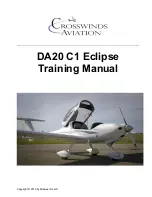
- 13 -
88.
Locate the two packs of Dubro E-Z Connectors included in the kit (you will have one
connector spare). Install the Dubro E-Z connectors onto the control horns. Just use the re-
useable nylon push-nut for now until its position on the control horn has been finalized. The
second hole from the top is a good place to start. Later, when you’re sure about their
position, it’s a good idea to remove the nylon push-nuts and replace them with the
permanent metal ones. I usually also then put back the nylon ones over the top as well… just
to be sure to be sure.
89.
Locate the three metal pushrods (with
attached steel clevises) included in the kit.
Screw the clevises so that they are
positioned towards the middle of the
threaded section of the rods to allow
adjustment either way if required. If using
a mini size servo with standard nylon
gears, it is a good idea to make a “v” bend
in the pushrods directly behind the
threaded section. This helps absorb shocks
to the servo initiated by the control surface
being hit, reducing the likelihood of the
servo gears getting stripped and requiring
replacement (annoying).
90.
Push the metal pushrod through the hole in the elevator’s E-Z connector (ensuring its lock-
screw is unwound) and attach the clevis to your servo arm, clamping together with a pair of
pliers. Repeat for both the aileron’s pushrods.
91.
Turn on your receiver and transmitter so that the servo arms are centered. While holding the
pushrod in place, move the elevator (the E-Z connector should be free to slide up and down
the pushrod) so that it forms a straight line continuation of the bottom surface of the airfoil.
Incidentally, if you glued the fixed trailing edge pieces accurately it should also line up with
these. While in this position, firmly tighten the lock-screw on the EZ-connector to fix it to
the pushrod.
92.
Repeat for both of the ailerons. Accurate alignment is particularly critical for these.
93.
Trim off the excess length of the pushrods using a pair of side-cutters/pliers.
FIN ATTACHMENT
Attachment of the front portion of the fins can either rely on a friction fit into the foam or be
held in place with tape as per the following procedure. We suggest not gluing them into place
because it can make replacing them after damage difficult.
94.
Remove the covering from over the fin slots on the top surface of the wing and insert the
fins into the wing so they butt up against the contour of the top surface of the wing.
95.
While in this position, mark a 10mm (3/8”) long line at the leading edge of each of the fins
level with the top surface of the wing.
96.
Remove the fins and cut a 10mm (3/8”) long slit through the leading edge of each fin along
the lines you marked.
97.
Take a length of cross-weave filament tape and apply covering to it to match the top surface
of the wing near the fin. Alternatively use a good quality thick clear tape that is UV
resistant.


























